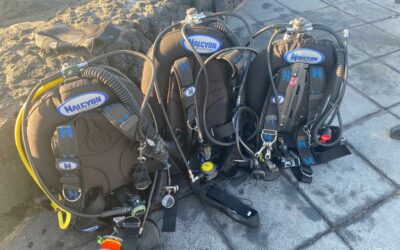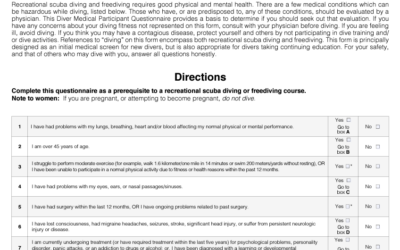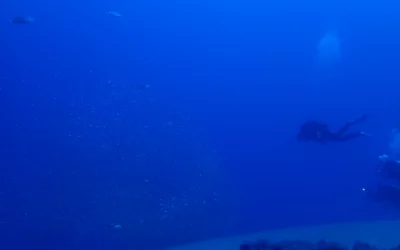In our previous Buoyancy Sessions you have learned to dive proper weighted, to perform a controlled descent and to adjust your weight in such a way that, by now, your trim must be beautiful. If you have achieved all this, you should have noticed a considerable improvement in your buoyancy. But, for now, practically everything you’ve learned is to make adjustments in your equipment so that nothing will hinder you in achieving perfect buoyancy. It’s time to take real control of your buoyancy. In our fifth session our advice is focused on all those tools that will allow you to dive like a fish.
TAKE CONTROL OF YOUR BUOYANCY
1 – THE BREATHING
The breathing is the master key for buoyancy control. Remember that when we breath in, we ascend slightly and conversely, when we breathe out, we descend. Your first step is to get a normal breathing rhythm. Normal means that neither you breathe too fast nor breathe too slow. Think that if, for example, you breathe too fast, the effect will be similar to having your lungs permanently filled with air. This will make you buoyant. To make matters worse, having your lungs full of air will cause your chest to rise, placing you upright and ruining your beautiful trim.
A quick tip: A standard interval you can start with is to inhale in 4 seconds and exhale in 6 seconds. This is a guideline interval. Remember that each diver is different. Thus, you must find your own rhythm. You can find out that, for example, you need 6 to inhale and 12 to expire. But what is important to understand is that if you breathe in less than 4 seconds and you expire in less than 6, you are breathing too fast.
Sometimes one does not breathe because of the need to breathe. There will be moments that you will breathe depending on the direction you want to go.
Example: Let’s say that you are breathing in when suddenly, you see something in the bottom. You interrupt your breath to blow out the air of your lungs and thereby get closer to that interesting thing. When you are getting close to your target, you breath in again, to avoid crashing against the bottom. You hover quietly while you enjoy whatever it is that caught your eye. When you want to continue your immersion, you simply perform a long and deep inspiration that elevates you to the initial level.
This is how we control our level in small variations through breathing. If you can do this, you will have reached a very good buoyancy. Well done! If you do all this without thinking about it, just instinctively, congratulations, you are already a buoyancy master!
2 – ANTICIPATION
What is the difference between a diver with a good buoyancy and a buoyancy master? Anticipation: To be able to see the changes that are going to happen in your buoyancy and make the necessary adjustments before they happen. You know that any change in our buoyancy is always slight delayed. Advancing such changes at the right moment is something that requires time and practice. But it is not difficult. With enough experience it will become instinctive. Until then, you only have one option, keep practicing.
The adjustment of your BC:
While diving, you should adjust your BC everytime you make a significant depth change. Remember this forever and ever. You should know that when we ascend, we must deflate our vest. When we descend we must inflate it. The amount of air to be added/ released will depend on how big the depth change is.
The difference between a diver with a good buoyancy and a buoyancy master is the Anticipation: to be able to see the changes that are going to happen in your buoyancy and make the necessary adjustments before they happen.
Example: If you see that you are going from the sandy bottom to the top of the reef, at that point you already know that you will need to adjust your BC. Anticipate – do not wait until you get to the top, since it might be too late. It is much better to progressively deflate while ascending and thereby, when reaching the top, your buoyancy will be practically neutral.
Breathing:
You know that if you are inspiring soon or later you will ascend. When you are controlling your depth with the breath you must be mentally ready. You must anticipate the effects that your breathing produces in your buoyancy. Be prepared to expire as soon as you notice that your fleet. As you breathe in, be ready to breath out. The sooner you correct it, the less you will have to adjust to the changes.
3 – SLOW YOUR MOVEMENTS
Reduce your movements as much as possible. Even better, do not move at all. Any movement can cause you to lose your balance. Instinctively this produces a second movement to recover that balance. Save your energy for swimming. The rest is an unnecessary waste. Hold hands to avoid moving them by instinct. You should adjust your balance with shoulders and hips. Any strong movement will change not only your balance, but your breathing. If you permanently move your arms, your breathing can not be as calm as if you were still.
4 – KICK AND GLIDE
What you want to do is what we call “Kick and Glide”. You kick once and then you glide a few meters hovering over the bottom. It is a soft and calm kick. There is no hurry. As I always say, we have to dive like if we were shopping. Looking through the shop windows, stopping to check better what interests us…
Practice it on your next dive. Kick and wait few seconds before your next kick. As these seconds pass, glance around. Observe what surrounds you. You will suddenly be able to waste time with each coral, each fish.
Swimming strong and fast will make you miss much of the aquatic life that is hidden in holes, camouflaged or in the sand. You’re going to exhaust, causing your breath to speed up destroying your buoyancy and increasing your air consumption. Remember, diving is synonymous of relax, peace and harmony . What peace is there in swimming like you were in a race? If you swim fast, you will end your immersion sooner, tired, stressed and having seen only 20% of what you could have seen.
5 – YOUR EXPERIENCE
Patently, all our advices seem easy from the point of view of who has already made a few thousand dives. Do not despair. Mastery comes from knowledge and experience. We provide you with the knowledge but only you can put the experience. Diving, diving and more diving. It is the only way.
There will be good days when everything will work out for you. Other days without knowing why, you will not feel completely at ease with your buoyancy. It does not matter. It is part of the process. If you like to dive and you plan to continue doing so, you will not be able to avoid gaining experience. By following our advices, you will get the maximum of every minute you are underwater.



